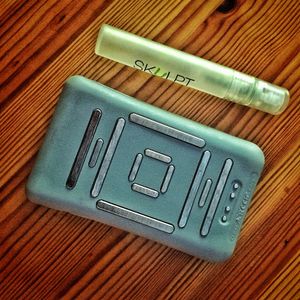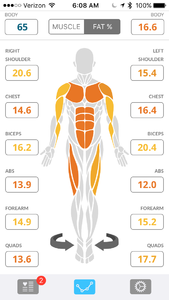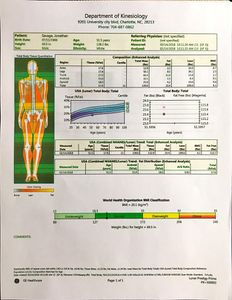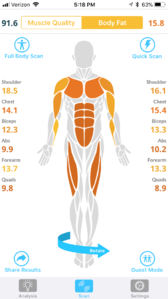Skulpt
Skulpt is a small device, a little bigger than a deck of playing cards that estimate body fat and muscle quality. I've found it to be one of the most useful ways of estimating body fat. It uses a similar principle to Body Fat Scales, sending an imperceptible electrical current through the skin. However, there are a number of key differences between Skulpt and body fat scales.
- Typical scales measure overall body fat through 2 or 4 electrodes on your hands and/or feet, where Skulpt uses 12 electrodes close together to measure body fat over an area of about 2" x 3" (5cm x 8cm).
- Skulpt measures up to 24 specific body locations, and it can estimate overall body fat from three measurements on your triceps, abdominals, and quadriceps.
- Unlike body fat scales, Skulpt has to have wet electrodes to function, so you have to spray the electrodes with water before testing each area.
- One reason for having so many electrodes is to pass a current along and across the muscle fibers. This allows the Skulpt to estimate "muscle quality", something that I thought was nonsense until I reviewed the available research.
- The Skulpt has to be sprayed with water before use, which is annoying. If you don't spray evenly over all the electrodes, you don't get a reading, though that's far better than getting a bad reading. I've found that spraying the sensor and applying it twice to pre-dampen the skin seems to produce more consistent results.
- Unlike scales, where you don't have to worry too much about positioning, Skulpt is quite sensitive to location. Of course, this is actually more about how you define it varies by location, so changing the Skulpt position changes how much fat it will be over. Some locations are easier to be consistent than others. For instance, it's easy to be consistent on the abdominals, as the naval can be used as a convenient landmark, where it's far harder on the quadriceps.
- Skulpt doesn't provide any indication of body weight, but by the same token, its estimate of body fat isn't dependent on body weight as an input. I think this makes Skulpt a little more reliable than body fat scales.
- Skulpt doesn't use any data about which body part is being measured in its estimate. So, if you measure your quads, it will give the same value even if you tell it you're measuring your triceps.
- Like body fat scales, Skulpt is sensitive to hydration and electrolyte balance. Some of this is simply because hydration will change body fat percentage directly. If you have 10Kg of body fat and weigh 100 Kg, your fat is 10%. Drink 2 Kg of water and you weigh 102 Kg and have a body fat of 9.8%.
I've been using the Skulpt for about 3 years, and over that time I found it to be quite useful in assessing my body composition. I periodically do a full body scan, but this is too tedious and time-consuming for me to perform frequently. While the "quick scan" of 3 locations to estimate overall body fat is interesting, I've found that simply measuring my right abdominal body fat gives me the most useful indication for the time spent. My physique tends to accumulate fat around my abdomen, with relatively little change on my arms or legs, so knowing my abdominal fat is the most interesting value.
1 Is Skulpt Worth It?
I think for the price, Skulpt is a worthwhile purchase. I've found its estimate of body fat is credible and a actionable, especially as many don't put on body fat evenly, but like many people accumulated in specific areas.
2 Compared with DEXA
I recently had a DEXA scan, and I compared the values with Skulpt. DEXA estimated overall body fat at 17.6% and Skulpt at 15.8%, which is reasonably close. The values for my legs are rather more believable with Skulpt than DEXA. As you'd expect from a runner, I have extremely lean, muscular legs, so the Skulpt estimate of 8-10% seems more credible than the DEXA estimate of 17.8%.
3 Muscle Quality
While the idea of measuring muscle quality seems like pseudo-science, there's quite a bit of research supporting the approach. This technique, known as "Electrical Impedance Myography", was developed for the evaluation of degenerative diseases. I won't attempt to summarize the research, but if you're interested I would recommend doing searching on Google scholar for "Electrical Impedance Myography", and this 2009 review is a reasonable starting point: [1]. The usefulness of muscle quality information is a little harder to evaluate. Not surprisingly, I found my legs had great muscle quality where my arms were rather poor, something that persuaded me to do a little bit of upper body strengthening. So far, I haven't found any correlation between Delayed Onset Muscle Soreness (DOMS) and the indicated muscle quality. I've done enough Treadmill Descent training to reach 2/5 on my DOMS Scale and 3/6 on the Likert Scale Muscle Soreness, and there was no change in the Skulpt Muscle Quality. However, I'm probably close to the top of the range for Muscle Quality in my quads, with absolute values of 145-160 and percentages just under 100%.
- Category:Beginners
- Category:Training
- Category:Nutrition
- Category:Weight
- Category:Ketogenic
- Category:Review




